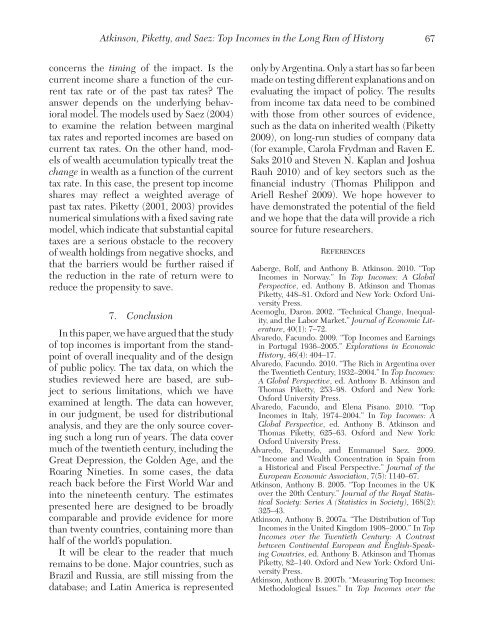"Top Incomes in the Long Run of History" with Tony Atkinson and
"Top Incomes in the Long Run of History" with Tony Atkinson and
"Top Incomes in the Long Run of History" with Tony Atkinson and
You also want an ePaper? Increase the reach of your titles
YUMPU automatically turns print PDFs into web optimized ePapers that Google loves.
Atk<strong>in</strong>son, Piketty, <strong>and</strong> Saez: <strong>Top</strong> <strong>Incomes</strong> <strong>in</strong> <strong>the</strong> <strong>Long</strong> <strong>Run</strong> <strong>of</strong> History67concerns <strong>the</strong> tim<strong>in</strong>g <strong>of</strong> <strong>the</strong> impact. Is <strong>the</strong>current <strong>in</strong>come share a function <strong>of</strong> <strong>the</strong> currenttax rate or <strong>of</strong> <strong>the</strong> past tax rates? Theanswer depends on <strong>the</strong> underly<strong>in</strong>g behavioralmodel. The models used by Saez (2004)to exam<strong>in</strong>e <strong>the</strong> relation between marg<strong>in</strong>altax rates <strong>and</strong> reported <strong>in</strong>comes are based oncurrent tax rates. On <strong>the</strong> o<strong>the</strong>r h<strong>and</strong>, models<strong>of</strong> wealth accumulation typically treat <strong>the</strong>change <strong>in</strong> wealth as a function <strong>of</strong> <strong>the</strong> currenttax rate. In this case, <strong>the</strong> present top <strong>in</strong>comeshares may reflect a weighted average <strong>of</strong>past tax rates. Piketty (2001, 2003) providesnumerical simulations <strong>with</strong> a fixed sav<strong>in</strong>g ratemodel, which <strong>in</strong>dicate that substantial capitaltaxes are a serious obstacle to <strong>the</strong> recovery<strong>of</strong> wealth hold<strong>in</strong>gs from negative shocks, <strong>and</strong>that <strong>the</strong> barriers would be fur<strong>the</strong>r raised if<strong>the</strong> reduction <strong>in</strong> <strong>the</strong> rate <strong>of</strong> return were toreduce <strong>the</strong> propensity to save.7. ConclusionIn this paper, we have argued that <strong>the</strong> study<strong>of</strong> top <strong>in</strong>comes is important from <strong>the</strong> st<strong>and</strong>po<strong>in</strong>t<strong>of</strong> overall <strong>in</strong>equality <strong>and</strong> <strong>of</strong> <strong>the</strong> design<strong>of</strong> public policy. The tax data, on which <strong>the</strong>studies reviewed here are based, are subjectto serious limitations, which we haveexam<strong>in</strong>ed at length. The data can however,<strong>in</strong> our judgment, be used for distributionalanalysis, <strong>and</strong> <strong>the</strong>y are <strong>the</strong> only source cover<strong>in</strong>gsuch a long run <strong>of</strong> years. The data covermuch <strong>of</strong> <strong>the</strong> twentieth century, <strong>in</strong>clud<strong>in</strong>g <strong>the</strong>Great Depression, <strong>the</strong> Golden Age, <strong>and</strong> <strong>the</strong>Roar<strong>in</strong>g N<strong>in</strong>eties. In some cases, <strong>the</strong> datareach back before <strong>the</strong> First World War <strong>and</strong><strong>in</strong>to <strong>the</strong> n<strong>in</strong>eteenth century. The estimatespresented here are designed to be broadlycomparable <strong>and</strong> provide evidence for morethan twenty countries, conta<strong>in</strong><strong>in</strong>g more thanhalf <strong>of</strong> <strong>the</strong> world’s population.It will be clear to <strong>the</strong> reader that muchrema<strong>in</strong>s to be done. Major countries, such asBrazil <strong>and</strong> Russia, are still miss<strong>in</strong>g from <strong>the</strong>database; <strong>and</strong> Lat<strong>in</strong> America is representedonly by Argent<strong>in</strong>a. Only a start has so far beenmade on test<strong>in</strong>g different explanations <strong>and</strong> onevaluat<strong>in</strong>g <strong>the</strong> impact <strong>of</strong> policy. The resultsfrom <strong>in</strong>come tax data need to be comb<strong>in</strong>ed<strong>with</strong> those from o<strong>the</strong>r sources <strong>of</strong> evidence,such as <strong>the</strong> data on <strong>in</strong>herited wealth (Piketty2009), on long-run studies <strong>of</strong> company data(for example, Carola Frydman <strong>and</strong> Raven E.Saks 2010 <strong>and</strong> Steven N. Kaplan <strong>and</strong> JoshuaRauh 2010) <strong>and</strong> <strong>of</strong> key sectors such as <strong>the</strong>f<strong>in</strong>ancial <strong>in</strong>dustry (Thomas Philippon <strong>and</strong>Ariell Reshef 2009). We hope however tohave demonstrated <strong>the</strong> potential <strong>of</strong> <strong>the</strong> field<strong>and</strong> we hope that <strong>the</strong> data will provide a richsource for future researchers.ReferencesAaberge, Rolf, <strong>and</strong> Anthony B. Atk<strong>in</strong>son. 2010. “<strong>Top</strong><strong>Incomes</strong> <strong>in</strong> Norway.” In <strong>Top</strong> <strong>Incomes</strong>: A GlobalPerspective, ed. Anthony B. Atk<strong>in</strong>son <strong>and</strong> ThomasPiketty, 448–81. Oxford <strong>and</strong> New York: Oxford UniversityPress.Acemoglu, Daron. 2002. “Technical Change, Inequality,<strong>and</strong> <strong>the</strong> Labor Market.” Journal <strong>of</strong> Economic Literature,40(1): 7–72.Alvaredo, Facundo. 2009. “<strong>Top</strong> <strong>Incomes</strong> <strong>and</strong> Earn<strong>in</strong>gs<strong>in</strong> Portugal 1936–2005.” Explorations <strong>in</strong> EconomicHistory, 46(4): 404–17.Alvaredo, Facundo. 2010. “The Rich <strong>in</strong> Argent<strong>in</strong>a over<strong>the</strong> Twentieth Century, 1932–2004.” In <strong>Top</strong> <strong>Incomes</strong>:A Global Perspective, ed. Anthony B. Atk<strong>in</strong>son <strong>and</strong>Thomas Piketty, 253–98. Oxford <strong>and</strong> New York:Oxford University Press.Alvaredo, Facundo, <strong>and</strong> Elena Pisano. 2010. “<strong>Top</strong><strong>Incomes</strong> <strong>in</strong> Italy, 1974–2004.” In <strong>Top</strong> <strong>Incomes</strong>: AGlobal Perspective, ed. Anthony B. Atk<strong>in</strong>son <strong>and</strong>Thomas Piketty, 625–63. Oxford <strong>and</strong> New York:Oxford University Press.Alvaredo, Facundo, <strong>and</strong> Emmanuel Saez. 2009.“Income <strong>and</strong> Wealth Concentration <strong>in</strong> Spa<strong>in</strong> froma Historical <strong>and</strong> Fiscal Perspective.” Journal <strong>of</strong> <strong>the</strong>European Economic Association, 7(5): 1140–67.Atk<strong>in</strong>son, Anthony B. 2005. “<strong>Top</strong> <strong>Incomes</strong> <strong>in</strong> <strong>the</strong> UKover <strong>the</strong> 20th Century.” Journal <strong>of</strong> <strong>the</strong> Royal StatisticalSociety: Series A (Statistics <strong>in</strong> Society), 168(2):325–43.Atk<strong>in</strong>son, Anthony B. 2007a. “The Distribution <strong>of</strong> <strong>Top</strong><strong>Incomes</strong> <strong>in</strong> <strong>the</strong> United K<strong>in</strong>gdom 1908–2000.” In <strong>Top</strong><strong>Incomes</strong> over <strong>the</strong> Twentieth Century: A Contrastbetween Cont<strong>in</strong>ental European <strong>and</strong> English-Speak<strong>in</strong>gCountries, ed. Anthony B. Atk<strong>in</strong>son <strong>and</strong> ThomasPiketty, 82–140. Oxford <strong>and</strong> New York: Oxford UniversityPress.Atk<strong>in</strong>son, Anthony B. 2007b. “Measur<strong>in</strong>g <strong>Top</strong> <strong>Incomes</strong>:Methodological Issues.” In <strong>Top</strong> <strong>Incomes</strong> over <strong>the</strong>















